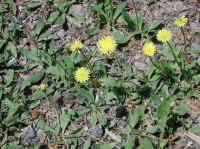 Mouse-ear
Hawkweed (Hieracium pilosella)
Mouse-ear
Hawkweed (Hieracium pilosella)
Wild Flowers of Sleepy Hollow Lake From All-Creatures.org Art and Photo Journals and Galleries Directory
Dedicated to the Preservation and Restoration of the Whole of Creation: Humans - Animals - Environment
"And God saw all that He had made, and behold, it was very good.
And there was evening and there was morning, the sixth day" (Genesis 1:31)
Mouse-ear Hawkweed (Hieracium pilosella)
Table of Contents
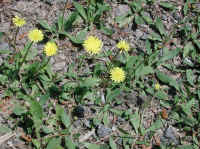
(Mouse-ear Hawkweed (Hieracium pilosella) - 01)
This cluster of mouse-ear hawkweed was growing on the side of the road, a common
habitat for this wild flower. The literature says that mouse-ear hawkweed
blooms from June-October, but we have only seen it bloom in the spring, and
sometimes as early as late May. We took this photo on June 2nd.
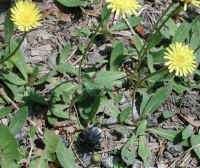
(Mouse-ear Hawkweed (Hieracium pilosella) - 02)
Mouse-ear hawkweed grow to heights 4-12 inches, and have only a rosette of basal
leaves with a solitary bloom on top of a leafless stem. The leaf rosettes
can be relative sparse. as these are, or they can grow quite thick. The
leaves, which can grow as long as four inches, have white hairs. Mouse-ear
hawkweed usually grow in clusters that develop from their interconnected root runners.
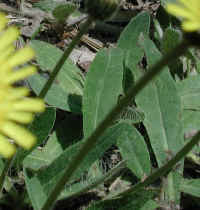
(Mouse-ear Hawkweed (Hieracium pilosella) - 03)
When looking straight down at the basal rosette, it is difficult to see the
hairs. To see the long white hairs, it is best to provide some contrast,
and to look at an angle, as we are doing in this photo. The more mature
leaves also have a distinctive light green to white mid vein.
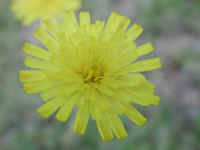
(Mouse-ear Hawkweed (Hieracium pilosella) - 04)
This photo provides us with a closer look at the one inch diameter flowerhead,
which some people say looks like a dandelion (which is true when viewed at a
distance), but which is quite different when viewed close up. As with all
members of the Aster family (Asteraceae), the mouse-ear hawkweed flowerhead is
composed of numerous central disc flowers surrounded by many ray flowers.
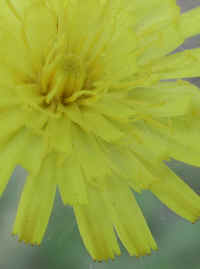
(Mouse-ear Hawkweed (Hieracium pilosella) - 04a)
In this bee's eye view of a portion of a mouse-ear hawkweed 1 inch diameter
flower head, we can see more of the details of the central disc flowers, which
are just beginning to open around the edge of the disc, and the perimeter ray
flowers with the toothed end of the ray flower petals. The white silky
strands clinging to the flowerhead are from the seeds of a cottonwood tree.
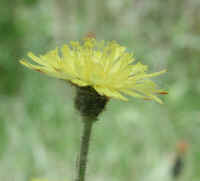
(Mouse-ear Hawkweed (Hieracium pilosella) - 05)
This is a side view of a 1-inch diameter mouse-ear hawkweed flowerhead.
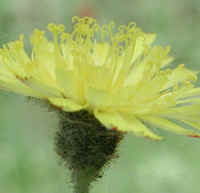
(Mouse-ear Hawkweed (Hieracium pilosella) - 05a)
In this close-up side view of the mouse-ear hawkweed flowerhead, we can see the
tiny hairs on the bracts and stem, and the curled split stigma on top of the
pistils sticking up above the flowers.
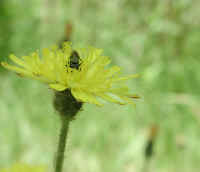
(Mouse-ear Hawkweed (Hieracium pilosella) - 06)
As we were taking these photos of the mouse-ear hawkweed, a visitor came by to
have lunch on the nectar and collect so of the pollen.
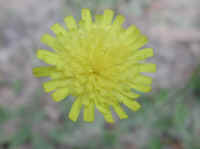
(Mouse-ear Hawkweed (Hieracium pilosella) - 07)
This is another view of a mouse-ear hawkweed flowerhead. This wildflower
is a native of Europe, and is now found throughout the northeastern United
States and as far south as North Carolina.
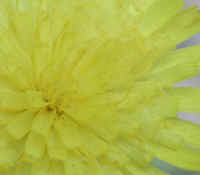
(Mouse-ear Hawkweed (Hieracium pilosella) - 08)
This is another bee's eye view of a portion of the flowerhead of a mouse-ear hawkweed.
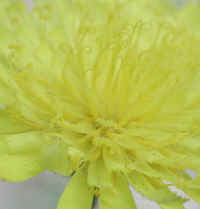
(Mouse-ear Hawkweed (Hieracium pilosella) - 09)
In this semi-side view of the flowerhead of a mouse-ear hawkweed, we can see
more of the detail of some of the ray flowers.
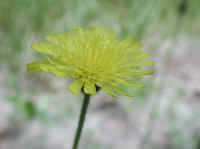
(Mouse-ear Hawkweed (Hieracium pilosella) - 10)
This is another view of a mouse-ear hawkweed flowerhead.
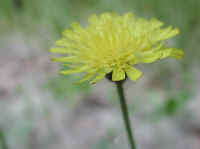
(Mouse-ear Hawkweed (Hieracium pilosella) - 11)
This is another look at a flowerhead of a mouse-ear hawkweed.
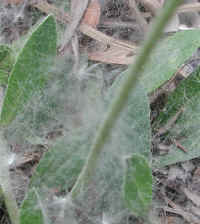
(Mouse-ear Hawkweed (Hieracium pilosella) - 12)
A few days after we took the first photos of the mouse-ear hawkweed leaves, they
became so covered with cottonwood "fuzzies" that it became more difficult to
distinguish the leaf hairs.
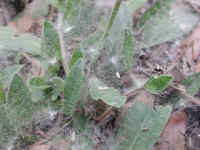
(Mouse-ear Hawkweed (Hieracium pilosella) - 13)
This is another look at the cottonwood fuzz covered basal leaves of the
mouse-ear hawkweed. Notice how hard it is to distinguish the white leaf
hairs from the fuzz.
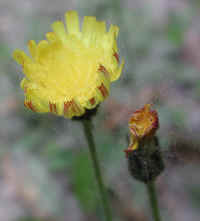
(Mouse-ear Hawkweed (Hieracium pilosella) - 14)
This is a newly opening flowerhead of a mouse-ear hawkweed with the mostly
closed bud of a flowerhead of a adjacent plant.
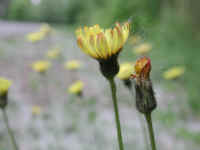
(Mouse-ear Hawkweed (Hieracium pilosella) - 15)
This is a side view of the newly blooming mouse-ear Hawkweed.
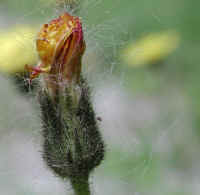
(Mouse-ear Hawkweed (Hieracium pilosella) - 16)
This is a close-up side view of a mouse-ear hawkweed bud that is just beginning to open.
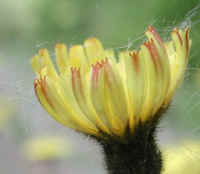
(Mouse-ear Hawkweed (Hieracium pilosella) - 16a)
This mouse-ear hawkweed flowerhead is about half way opened.
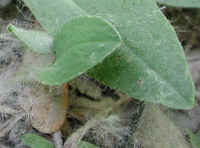
(Mouse-ear Hawkweed (Hieracium pilosella) - 17)
In this photo we have a closer look at the hairs on the mouse-ear hawkweed.
We believe that the name came about because the newly opening leaves look
something like a mouse's ear (see the smaller leaf growing out from under the left
side of the larger leaf).
| Wild Flowers of SHL: Photo Identification, Common Name, Scientific Name | Art and Photos |

 Presented here are just a few of the countless components of God's creation.
Just as we cannot have human and animal life without water and plants, neither
can we have lasting peace without love and compassion. It is our hope and
prayer that this series will motivate people to live and act in a cruelty-free
manner; that we would no longer hurt or destroy each other, the animals or our
environment.
Presented here are just a few of the countless components of God's creation.
Just as we cannot have human and animal life without water and plants, neither
can we have lasting peace without love and compassion. It is our hope and
prayer that this series will motivate people to live and act in a cruelty-free
manner; that we would no longer hurt or destroy each other, the animals or our
environment.






